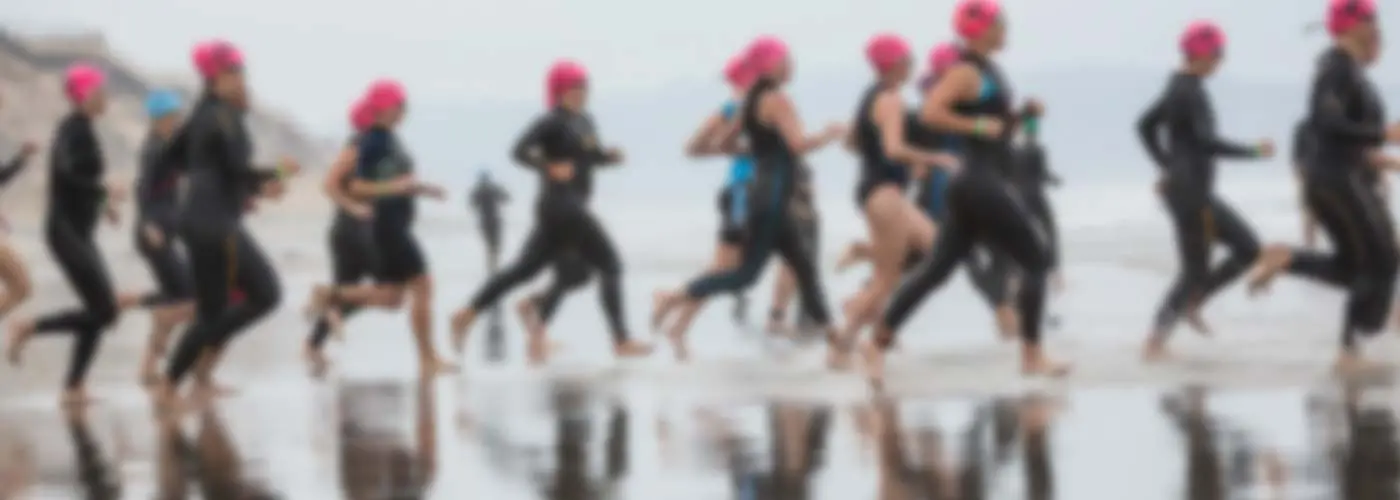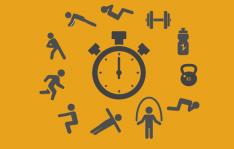Weak glutes can lead to back, hip and knee pain, as well as injuries. If you sit for the majority of your days, more than likely your hip flexors are weak and short, and your glute muscles are literally clumped together and inactive. When we move from that position into an active training state, we work in a state of inefficiency, using poor mechanics.
Optimizing the glutes opens the door for better body positioning, increased comfort and lasting power. Think of running faster and longer. Think of being more stable and efficient on the bike. Think of swimming with a stronger and more fluid leg kick.
Try these six exercises to develop and optimize your glute power.
Clam, Part 1
2 of 7
Setup: Lie on your side with hips bent at a 45-degree angle and knees bent at approximately a 90-degree angle. Your bottom arm can be straight out from shoulder, under your ear, with palm facing up or bent at the elbow to provide higher support for the head. Your top hand should be on the floor in front of your chest to provide stability and support. Engage both sides of your waist for core support and make sure to have your hips stacked.
Move: Inhale to prepare. Exhale, opening the top knee towards the ceiling, squeezing the heels together and keeping the hips stacked. Inhale and return the knee back home. Do 5 to 8 reps on each side.
Think: As the knee opens into your clam, make sure to not pull the top hip back. This is very common when trying to get more range. Focus instead on keeping integrity throughout your whole body. Use the Gluteus Medius (you should feel it right in the center of your glute) to open the knee and focus on opening the front of the hip from your groin.
Why: Clam is an excellent exercise to work the Gluteus Medius while lubricating the hip joint—a much needed movement as our hips often become stuck from sitting too much, training without performing corrective exercises and overall tightness.
Find:
Your Next RaceClam, Part 2
3 of 7
Setup: Lie on your side with hips bent at a 45-degree angle and knees bent at approximately a 90-degree angle. Your bottom arm can be straight out from shoulder, under your ear, with palm facing up or bent at the elbow to provide higher support for the head. Your top hand should be on the floor in front of chest to provide stability and support. Engage both sides of your waist for core support and make sure to have your hips stacked.
Move: From the clam position, inhale to bring your feet up off of the floor, keeping the knees down. Exhale to open the top knee to ceiling, squeezing the heels together. Inhale to return the knee. Do 5 to 8 reps each side.
Think: Keep your feet off of the floor the whole time. Keep your hips stacked and avoid pushing the top hip forward as this is often the case when the feet are up. Also, avoid allowing the top shoulder to compensate by shrugging up or forward.
Why: This progression of the clam takes you deeper into the external rotation. It calls for more support in the trunk and pelvis specifically. A more stable pelvis and open hips provide better mechanics in the lower limbs.
Find:
Your Next RaceClam, Part 3
4 of 7
Setup: Lie on your side with hips bent at a 45-degree angle and knees bent at approximately a 90-degree angle. Your bottom arm can be straight out from shoulder, under your ear, with palm facing up or bent at the elbow to provide higher support for the head. Your top hand should be on the floor in front of your chest to provide stability and support. Engage both sides of your waist for core support and make sure to have your hips stacked. Both feet should be off the floor with your knees down.
Move: Inhale to open the top knee to the ceiling. Keep the knee there. Exhale to reach the top foot out in line with the knee extending from your hip. Inhale to return the foot back home, with both feet still lifted off of the floor. Exhale to return the knee back home. Do 4 to 6 reps each side.
Think: Keep the hips stacked and pelvis stable throughout movement. When reaching the leg, reach all the way through the toes getting the full extension out of the top hip. Avoid dropping the bottom foot while moving the top leg.
Why: The progression of the clam here provides even more pelvic stability than in part two. The addition of extending the leg brings more integration of hip abduction, external rotation and leg extension. The Gluteus Medius as the primary muscle here—now working in a dynamic pattern—helps to provide overall hip, pelvic and leg stability and can ultimately help with knee pain due to instability.
Find:
Your Next RaceProne Hip Extension
5 of 7
Setup: Lie on your stomach with your hands under your forehead. Dig your pelvis into the floor so as to get some length in the lower back. Make sure your shoulders are down. Your legs should be long and reaching back through the toes.
Move: Inhale to extend one leg off the floor, keeping the leg straight. Exhale and lower the leg. Inhale to lift. Continue with the same leg then switch sides. Do 6 to 10 reps with each leg.
Think: This exercise is not primarily focused on the glutes, but it is important for proper hip extension. The hamstrings are the primary muscles used in this exercise, with the glutes and abdominals providing support. While moving the leg, focus on keeping the pelvis absolutely still. This exercise should not be using the muscles of the lower back.
Why: Proper hip extension is key for all things done standing and is essential for swim, bike and run sports. The mechanics of this exercise provide stability for the pelvis and give great length to the front of the hip and thigh when moving into extension.
Find:
Your Next RaceRainbow Arcs
6 of 7
Setup: Sit up on your elbows and knees with hips at approximately a 45-degree angle. Reach one leg back in line with the hip. Reach through your toes and get as much length as possible from the front of the hip. Keep your core active and shoulders engaged.
Move: Inhale and arc the leg up to the ceiling and then bring it down outside of the mat (the same side as the moving leg). Exhale and arc the leg back up to the ceiling and then down to the other side outside of the mat. Continue making this rainbow shape with your leg, inhaling to one side and exhaling to the other. Do 5 to 10 reps and then switch to the other leg.
Think: Keep the whole body active. Avoid sagging between the shoulder blades, dropping your head and sagging in the lower back. Maintain integrity throughout.
Why: This is a dynamic exercise calling for lots of stabilizers (upper body, shoulders, core and supporting leg). The Gluteus Maximus is the primary muscle mover for the moving leg while allowing mobility through the hip socket.
Find:
Your Next RaceSupported Single Leg Squat
7 of 7
Setup: Place a medium sized ball (a large physio ball works well too) between your back and a wall. Start with your back straight and feet slightly forward in front of your body. Raise one leg straight up off the floor with your arms reaching forward.
Move: Inhale and squat down with one leg, allowing the ball to ride up the back, providing support in motion. Exhale and stand back up through the leg. Continue on the same leg for 3 to 8 reps then switch sides.
Think: Make sure the supporting foot is facing forward and is not turned out. Allow the ball to provide support but avoid leaning on it from the start. Drive your hips down without compensating movement by tucking your hips. Keep your shoulders away from your ears.
Why: The single leg squat is a full-body exercise offering a challenge to many moving and stabilizing parts. Having one leg up highlights balance and control. The ball allows for better form and less chance for compromising the supporting knee. The Gluteus Maximus contracts eccentrically in this exercise to control the speed of the downward movement phase.







Discuss This Article